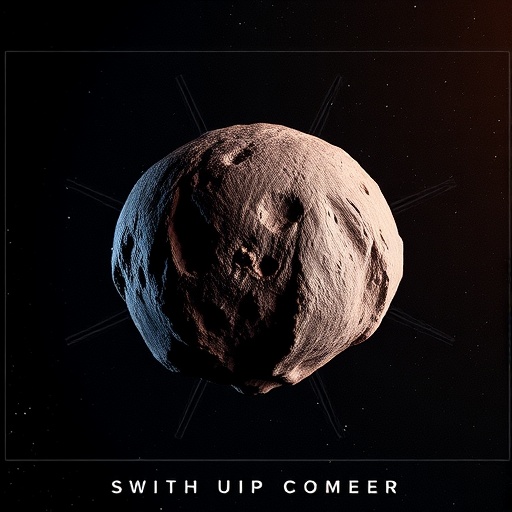Southwest Research Institute (SwRI) recently unveiled a groundbreaking mission study, focused on a proposed spacecraft designed to conduct a flyby of an interstellar comet. This mission aims to deliver unprecedented insights into the properties of celestial bodies that originate from beyond our solar system. Utilizing the recent discovery of comet 3I/ATLAS, the team at SwRI has validated the mission concept, demonstrating that 3I/ATLAS could have been intercepted and scientifically analyzed by the prospective spacecraft designed in their study.
The initial identification of interstellar bodies was marked by the arrival of the object 1I/‘Oumuamua in 2017, which was the first interstellar comet detected within our solar system. The object’s name reflects its Hawaiian origins, meaning “a messenger from afar arriving first.” This milestone was quickly followed by the discovery of the second interstellar comet, designated 2I/Borisov in 2019. Fast forward to the present, 3I/ATLAS made headlines as the third officially recognized interstellar object to traverse our solar system. With advancements in astronomical facilities, such as the National Science Foundation’s Vera Rubin Observatory, the astronomical community anticipates an uptick in the discovery of interstellar comets in the coming decade.
Beyond the charming nomenclature and exciting discoveries, the presence of these celestial travelers provides humanity with a once-in-a-lifetime opportunity to explore objects that formed in distant star systems. According to Dr. Alan Stern, Associate Vice President at SwRI and the lead on this pivotal study project, the proposed flyby mission could yield unprecedented insights into the composition, structure, and properties of these interstellar travelers. The implications are extensive, potentially enriching our understanding of the solid body formation processes that take place in other star systems while providing a new lens through which to view our universe.
Scientists estimate that numerous interstellar objects pass within Earth’s orbit annually, with as many as 10,000 crossing within Neptune’s orbit each year. This highlights the significant volume of extraterritorial material that interacts with our solar system, prompting the SwRI’s internal research team to address the unique design challenges associated with a mission to observe an interstellar comet. The study encompassed assessing the mission’s feasibility, costs, payload requirements, and the potential for groundbreaking scientific discoveries.
In order to design the mission trajectory options, SwRI researchers developed sophisticated software capable of generating a synthetic population of interstellar comets. The software then calculated minimum energy trajectories from Earth to each comet’s path. The calculations revealed that low-energy rendezvous trajectories are not only feasible but often require fewer resources in terms of launch and in-flight velocity than many current solar system missions.
Dr. Mark Tapley, an expert in orbital mechanics at SwRI, employed this software to derive the trajectory that the proposed spacecraft could utilize to intercept 3I/ATLAS, confirming that the mission could feasibly reach this intriguing comet. Tapley’s analysis underscores a significant conclusion: existing technology and launch capabilities, akin to those employed by NASA, can indeed facilitate encounters with interstellar comets like 3I/ATLAS.
The planned mission aims to undertake significant scientific observations during its near approach to 3I/ATLAS. According to Matthew Freeman, the project manager for the study, the value of data collected during the flyby could be immense. Notable scientific objectives encompass determining the physical properties of the interstellar body, thereby illuminating its formation and evolution. Additionally, examining the comet’s composition can offer crucial insights into its origins, providing context to the evolutionary forces that have sculpted it since its inception, including a thorough investigation into the comet’s coma—a gaseous envelope that escapes from the nucleus.
With the momentum generated by the emergence of interstellar comet 3I/ATLAS, the SwRI study gains additional validation, solidifying the case for an interstellar comet mission. The findings not only enhance our understanding of the mechanics involved in exploring such celestial bodies but also bridge past knowledge with future opportunities for exploration. As we continue to refine our understanding of these cosmic visitors, parallels can be drawn to the advances that sparked the exploration of our own solar system.
The proposal for a spacecraft destined for a flyby of interstellar comets represents a marvelous fusion of imagination, technology, and scientific inquiry, echoing the true spirit of exploration that characterizes humanity’s quest to understand its place within the cosmos. The data harvested from such a mission could rewrite our textbooks and inspire new generations to gaze in wonder at the night sky.
In summary, the groundwork laid by the SwRI study could pave the way for future missions to explore interstellar comets. Such missions promise to expand our knowledge of solid bodies formed in alien systems and refine our understanding of the universe we call home. With every new discovery, we inch closer to unlocking the mysteries of the cosmos, entering a new golden age of astronomical exploration.
Subject of Research: Interstellar Comet Exploration
Article Title: Toward the Stars: Unveiling the Secrets of Interstellar Comets Through Proposed Flyby Missions
News Publication Date: September 3, 2025
Web References: https://www.swri.org/markets/earth-space/space-research-technology?utm_campaign=interstellar-comet-pr&utm_source=eurekalert!&utm_medium=referral
References: Not applicable
Image Credits: NASA/ESA/UCLA/MPS
Keywords
Interstellar Comets, Space Missions, Southwest Research Institute, 3I/ATLAS, Astronomy, Spacecraft Design, Flyby Missions, Cosmic Exploration, Celestial Bodies, Scientific Discovery, Astrophysics, Orbital Mechanics.




